BOOKS
In addition to teaching and performing, Dhananjayan has also distinguished himself as a writer.
Book Title: BEYOND PERFORMING: ART & CULTURE (Politico-Social Aspects)
Author: V P Dhananjayan, Bharatanaatyam exponent and Guru, founder president, Bharatakalanjali, Adyar, Chennai.
On Dec 5, 2006, His Excellency Governor of Tamilnadu Shri Surjit Singh Barnala released the book at a special function at Raj Bhavan, Guindy. This book is edited by Dhananjayans' senior disciple Tulsi Badrinath and published by BR Rhythms, New Delhi. Dhananjayan's earlier book 'Dhananjayan on Indian Classical Dances' was also published by BRR and this has gone in for 3 editions. Success of this book prompted Dhananjayan to launch the present publication.
'Beyond performing: art & culture' contains various articles not only on art & culture matters, but also political and social aspects. An interesting attraction in the book is the cartoons on arts and social issues by late Sarathy. Dhananjayan's concern for the welfare of society and peaceful co-existence - both artistically and politically are very much evident and his forthright suggestions to Government and public agencies are thought provoking points. Cho Ramaswamy has written the foreword to this book.
The book is Priced @Rs.1195.00 available B.R.Rhythms, email: info@brrhythms.com
Review
An artist's perspective of social issues
By H. Ramakrishnan
The Hindu, Book Review, Feb 06, 2007
www.hinduonnet.com/br/2007/02/06/stories/2007020600481400.htm
His book, A DANCER ON DANCE is a publication that attempts to create an awareness of dance and its related problems in contemporary society. It is a collection of written articles and lectures delivered by him on a variety of subjects related to dance.
DHANANJAYAN ON INDIAN CLASSICAL DANCE) with a new look and more informative articles & pictures, will be soon in the market, owing to public interest and demand for this book.
For trade details and ordering for copies please contact the publisher:
M/s B.R.Rhythms
425, Nimri Colony, Ashok Vihar Phase-IV
New Delhi, 110052, India
Phone: 011+23259196 & 23259648
Email: info@brrhythms.com
THOUGHTS AND ACTIONS – 2 volumes edited by Dhananjayan. These books are a compilation of lectures presented by scholars at the Natya Kala Conference organised by Sri Krishna Gana Sabha, Chennai.
Dhananjayan is a regular contributor to Sruti magazine. He has written forewords to dance publications of other authors.
His articles on art and other socially relevant articles appear in the leading national publications like The Hindu and The Indian Express.
Dhananjayan’s articles are found in many souvenirs connected with Art institutions and other Socio-economic organizations.
*********
Offstage is a book celebrating the legendary Bharatanatyam dancers VP Dhananjayan & Shanta Dhananjayan through art.
Book Title: OFFSTAGE: An interesting account of the life experiences of the Dhananjayans
Created by: by Poonam Ganglani (Editor), Rohit Bhasi Satwik Gade, Alamelu Annhamalai (Illustrator)
This book is a visual voyage showcasing the Dhananjayans’ life and artistry of over six decades. Replete with the visual narratives illustrated by three different artists, the book encapsulates glimpses of the Dhananjayans’ lives and work, through a range of moods and styles - from contemplative and abstract, to entertaining and edge-of-seat.
The book, Priced @Rs.1400.00 is available on Amazon
Review
Book launch of 'Offstage'
By V.V. Ramani
e-mail: ramanigaru@gmail.com
The Narthaki, September 5, 2022
https://narthaki.com/info/rev22/rev2759.html
A striking black and white image of a dancer with a red bindi on the cover of a book grabbed attention, as one walked into the auditorium of Spastic Society of Tamilnadu ,which has become the new space for Bharata Kalanjali, the dance institution of the Dhananjayans. A closer look revealed the title of the book graphically positioned on the right side of the image. Titled 'Offstage,' the book that was being launched on that day was about stories and experiences of Shantha and Dhananjayan which needed to be shared, besides the many interviews they have given over the years, about their life and love in Kalakshetra.
"In the year 2018, when Bharata Kalanjali celebrated its golden jubilee, there were plans to bring out a souvenir. The very idea of a souvenir with photographs and articles was something I detested and thankfully the souvenir didn't see the light of the day," says Satyajit. "The idea of a book lingered on and both Anupama and I felt a strong need to move away from the beaten path. We soon conceptualized the idea of coming up with a book that would look at the dancing couple with a fresh perspective. We decided to share three different narratives of their life in a graphic manner, using drawings, illustrations and comics. The idea was that any adult or child walking into a bookshop should be excited to pick up the book without even knowing who The Dhananjayans were."
"This book touches upon a very important aspect of life – Love," said Jug Suraiya, columnist and writer who had come from Delhi to launch this book. "Love that Shanta and Dhananjayan have for each other, their shared love of the chosen art form - Bharatanatyam, the love for dance that they sowed in the minds of rasikas around the world, the love for the art between a master and disciple in their institution and above all, the love the children have for their parents. This book using the medium of graphic arts is also a labour of love."
Satyajit and Anupama were very clear from the beginning that the ideas they had, needed to be expressed in an artistic manner. Therefore they chose three artists with distinct styles to visualise the narratives. Details of some special moments, anecdotes and experiences, both personal and professional spanning many decades from their life, have been presented in a simple style to reach out to a wider audience.
The first section 'Auld Lang Syne' by Satwik Gade is through the eyes of a subjective observer in search of a metanarrative connecting then and now. Blending images and words to capture distinct episodes from the lives of the Dhananjayans, in the section 'Lines and Curves' visual artist Alamelu Annhamalai has used the mediums of charcoal, pen and ink. Illustrator and painter Rohit Bhasi in 'Tour de force' has used the medium of comic illustration to capture a series of absurd, unforgettable series of events from the Dhananjayans' tour of Nigeria in 1980.
The striking black and white photos are by Raghavendra Rao. Coordinated by ArtSpire team this book has been printed by Sudarshan Graphics.
Published by Bharata Kalanjali
ISBN: 978-81-955568-0-9
Price: Rs.1400
Language: English
*********
TELEVISION
The Dhananjayans have given many solo, duet and group performances on National television channels.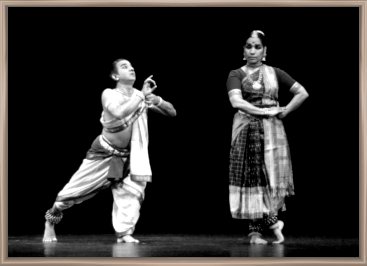
Details | Reviews | Photo Album

It was choreographed for Madras Doordarshan TV channel for the Vallathol Centenary celebrations in 1977
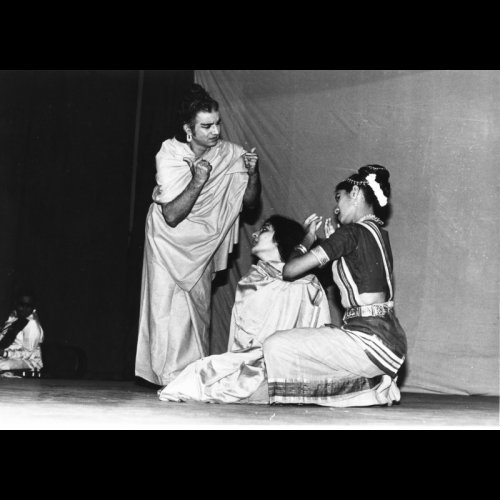
Details | Photo Album
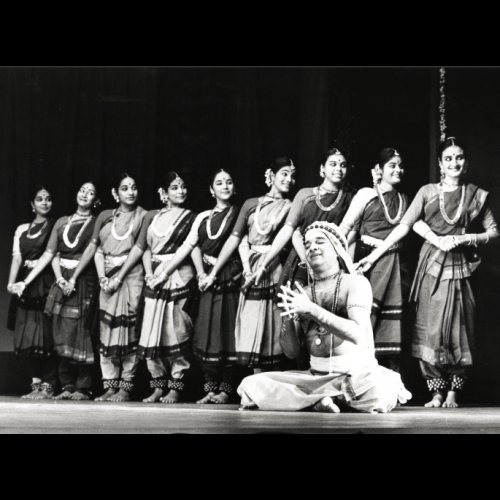
Their performances are telecast regularly on Indian television channels. Dhananjayan has conducted series of educative lecture demonstrations on South Indian classical dances on Asianet TV channel. Produced by Medimix Ayurvedic soap, it was a very popular program and had a high rate of viewership.
Details | Reviews | Photo Album
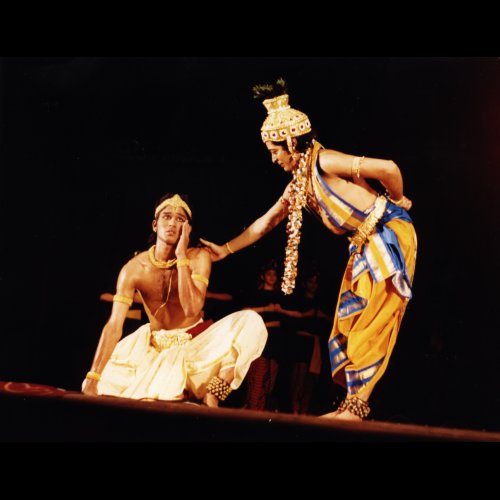
Details | Reviews | Photo Album
FILMS
MULTI-VISION FILM ON INDIA (1971)
Shanta has the rare honour of dancing for the Multi-Vision film on India, jointly produced by the Dept of Tourism, Govt. of India and a Belgian photographer.Their first film encounter was with the Tourism promotion and a famous Belgian photographer. Shivamoni Nathan and the Belgian crew travelled all over India to shoot for the promotion of Air India and India tourism. Their search brought them to Bharata Kalanjali one day and they selected Shanta as their model. This gave rise to a controversy since Shanta got the coveted assignment after an all India selection process!! The Belgian photographer stood firm on his choice of Shanta or he would not do the film. That caused quite a commotion! The political tussles over choice of model by the different departments brought the matter to a halt for a while
"It was a multi-exposure film medium. With slides, the whole thing was projected by multi-cameras like a film on a domed screen. I still have the slides that were shot in Kanchipuram. The choice was made out of nearly 15,000 slides and the film was shown all over the world. Air India and India Tourism promotion material carried Shanta’s photo. The publicity was a big boost for us."
HOLIDAY IN INDIA (1974)
The Dhananjayans and the Bharata Kalanjali unit have been featured in a film titled HOLIDAY IN INDIA produced on India by Paramount Pictures of Hollywood.Herbert Coleman, an associate director with Hitchcock, wanted to shoot a film in India on the theme of tourism. Diana Baker was the heroine. In the film, she travels to India and falls in love with Hindi actor Shammi Kapoor. Coleman traveled to India to scout for locations and subjects, including dance schools so as to shoot for a tourism promotion as well.
"He somehow liked our dance and wanted us to dance in his film. He confirmed our participation and left, but then we heard nothing from him for more than a year. One fine morning, Shivamoni Nathan (Director of Tourism) calls and says Coleman is here with his Bombay crew. We were confused since Shanta was pregnant then with Satyajit and would not be able to dance. On seeing this, Coleman was in shock! He had taken Shanta’s presence in the film for granted, and not knowing what to do, he went back to Savera Hotel where he was staying."
"There had obviously been a communication gap since he had intimated the concerned people about his plans. But he worked on a solution and we met next morning. He wanted me to choose one of my dancers to partner me but Shanta should also be in the film according to his now changed script. Diane would meet Shanta and say, “When I came last year, you were dancing. What happened now?” and Shanta says she is pregnant and so on."
Coleman felt this was a good idea because he could project the image of an Indian woman as a housewife and mother and yet pursue a profession. The sequence was shot in the Thiruvanmiyur temple where a platform was erected and the whole thing went off very well. Ambika Buch was Dhananjayan’s dance partner in the film, Shanta as well as their students featured in it too. Though the shooting took place, the film, unfortunately, did not see the light of day because of differences in opinion between the Tourism Dept. and the concerned production company. It is now in the Hollywood archives.
“We were contracted for Rs.10, 000 for a 10-day shooting schedule, normal for a 10-minute dance sequence. The surprising thing is, we completed shooting in 3 days! The producer was so happy that he gave us double the amount, a great help for us in those early days of struggle.”
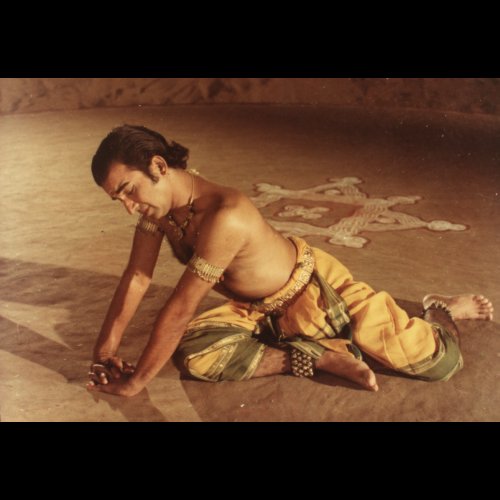
KANN SIVANDHAAL MANN SIVAKKUM (1983)
A Tamizh film by director Sridhar Raj.Sridhar had seen Dhananjayan’s solo portrayal of Nandanar Charitam. That time, there was a big upheaval in Thanjavur between laborers and landlords and somewhat resembled the Nandanar story, a revolutionary theme. So, with Poornima Jayaram in the lead, he wrote a story about an Indian girl from America, who comes to India to do research on the therukoothu tradition, goes to Thanjavur and gets involved in local politics.
Dhananjayan was supposed to figure as himself – a dance guru - and his half-hour dance drama Nandanar Charitam was to be featured intermittently wherever relevant, as part of the film. After some earlier fruitless experiences, he was hesitant to take on this offer but the director spent several days persuading him. For Dhananjayan, every assignment is important and he worked meticulously for a month preparing for this. He asked T V Gopalakrishnan to give vocal support. Ilayaraja, the music composer who composed the existing music beautifully, spent 2 weeks working with Dhananjayan, watching him rehearse. Along with the cameraman Soumendu Roy, Satyajit Ray’s cameraman, they all worked hard to make this a really monumental picturization.
The shooting took place for 2 weeks at night at Cholamandal Artists village, because the ambiance was good. Then there was a lull, nothing happened. In all, a month of preparation plus 2 weeks of the shooting had been put in.
“I was so vexed. I think the film ran only for 2 weeks, Sridhar even got an award. He was such a good director, it was evident in whatever instructions he gave me. Dancing for the camera is a different medium altogether and this experience taught me a lot of things.”
“After 2 years, the film was released with a lot of masala, the concept itself had changed. Pillayarai pidikka poi, korangaa mudinja kadhai!”
“After much persuasion, we all went to see the film on the last day. After shooting for a 30 minute slot, there was only a 3 minute sequence in the film!”
“When I came out, I was actually recognized. The front row audience consisting of rickshaw pullers and labourers surrounded me and congratulated me on my performance and asked why I had not danced more in the film. I told them the producers would know the answer to that. What touched me were the words of appreciation from the so-called poor people. It proves you don’t need great education to appreciate art.”
“The producers thought the film would not run because of the dance, but the film had so much classical value that it would have been an international hit if the original script and dance had been maintained.”
“This was my first close contact with this type of audience for me.”
Review
“The film portrays the Tamizh culture, the works of artist P Krishnamurthy, and the stirring story of Nandanar by Kannan Koothapiran portrayed by Dhananjayan. Why has the moving 15 minute presentation been cut down to 3 minutes?’ lamented S Seshachalam, the deputy director of Tamizh Eyal Isai Nataka Manram. ‘It is a matter of shame”, said he.
REEL EXPERIENCES!
"We have other costumes in mind for the apsaras..."
In 1978, producer/director Rajagopal, who was in advertising, wanted to make an ad film for manure using classical dance. The idea was, the celestials were celebrating Spring in the heavens. Stage actor ‘Heron’ Ramaswamy was Indian and he celebrates with his apsaras to the lovely music ‘vasantham vandhadhey’ of Radha and Jayalakshmi.Rajagopal wanted only a classical presentation, and he liked the tasteful costumes and special choreography of the Dhananjayans. It was in the early stages of Bharata Kalanjali’s development. The group went to Vahini Studios where a beautiful set of Indra’s durbar had been erected. After the first scene of the shooting, there was a big break, with a lot of whispers going on. Lunchtime came and went, director Rajagopal was not to be seen. At about 2 pm, Rajagopal’s assistant approached Dhananjayan and after much prompting, informed him that the producers of the film had other costumes in mind for the apsaras!
"We had put authenticity and aesthetic considerations into making the costumes especially for this film."
"As it happened, the proposed costumes were meant to be revealing and the director had vanished because of the resulting embarrassment! I refused to subject my students to this. Despite a month long preparation for this 4 minute dance sequence, we left."
Shoestrings and movie budgets...
In the early 1980’s, music director M B Srinivasan wanted Dhananjayan to do the dance choreography for a Malayalam film on Swati Thirunal, but the earlier experiences had put him definitely off films. Dhananjayan insisted on a contract and payment of choreographer fees for the 7 songs to be picturized. Malayalam films being famous for being shot on shoestring budgets, the producer said they could shoot a complete film in that budget and the venture fell through.The phone call from Chitradurga...
In 1976, G V Iyer, the director of grand, award-winning films on classics was making the Kannada film 'Hamsa Geethe'. Jayalakshmi Eswar, a Kalakshetra graduate who also worked with the Dhananjayans, has danced in this film, which is based on ashtapadis. Because it is a classic work, the Dhananjayans accepted without any conditions. The songs were even recorded with Mani Krishnaswamy’s voice. All the songs had been choreographed including Oothukadu’s Kalinga Narthana Thillana in Surutti, to denote a period item.
"As Kalakshetra products, we were all, including Mani akka (Mani Krishnaswamy), very meticulous. There was a long gap and we did not know what was happening. At that time, we did not have a telephone and my neighbours were asked to give me a message to report to Chitradurga at once. I did not even know what for. There was another call in the middle of the night and I was asked to report immediately at Chitradurga in Karnataka, since the sets were ready and so were the cast. I had to turn down the offer since we were leaving for the UK in a day or so."
"In desperation, they eventually contacted Adyar Lakshman and he made it to Chitradurga where he found out what had happened. Lakshman did a great job on the choreography and the film came out beautifully. They had retained tunes selected by Lingappa and me, but the songs were sung by M L Vasanthakumari and Balamuralikrishna."
